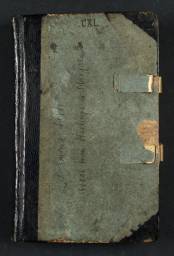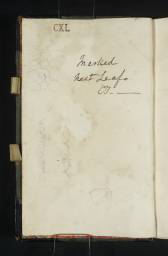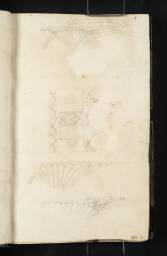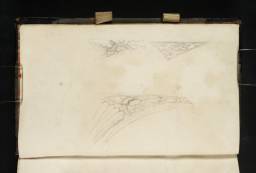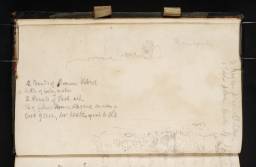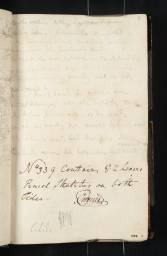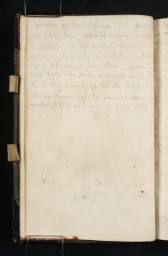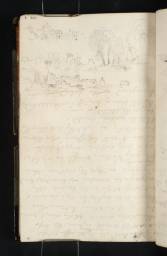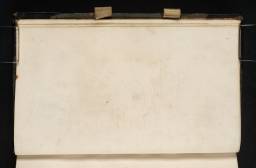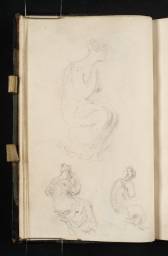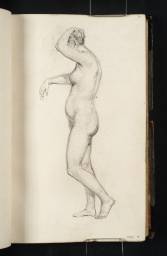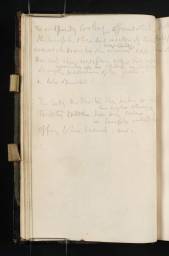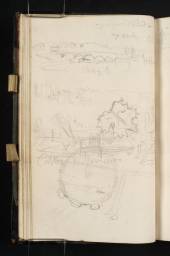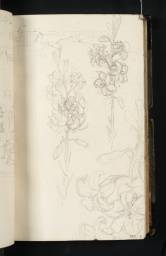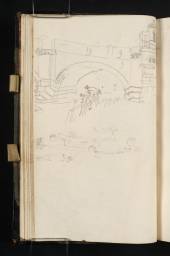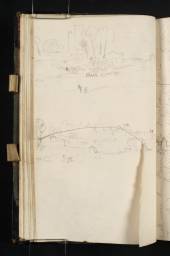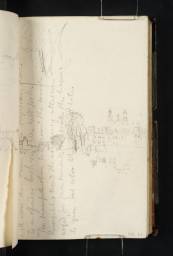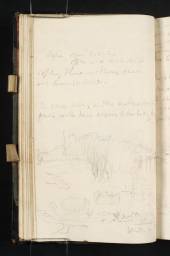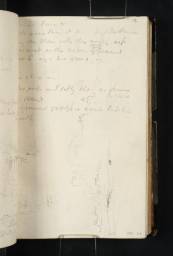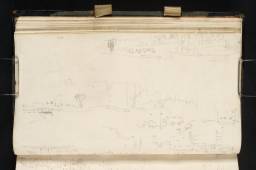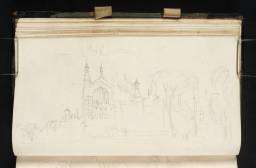Turner Bequest CXL
Sketchbook bound in boards with blue paper covers, black leather spine and corners, red and blue marbled endpapers and two vellum flaps or pencil holders
91 leaves of white wove paper
Approximate page size 155 x 95 mm
Watermarked ‘1813’
Inscribed by Turner in ink ‘Richmond Hill | Coast from Hastings to Margate’ on the front cover (D10409)
Endorsed by the Executors of the Turner Bequest ‘No.339. Contains 82 Leaves | Pencil sketches on both | sides’ and signed by Charles Turner in ink ‘C. Turner’ and by Charles Lock Eastlake and John Prescott Knight in pencil ‘C.L.E.’ and ‘JPK’ on folio 3 (D10414). Also inscribed by John Ruskin in blue ink ‘Cover of Invent 339’ inside back cover
91 leaves of white wove paper
Approximate page size 155 x 95 mm
Watermarked ‘1813’
Inscribed by Turner in ink ‘Richmond Hill | Coast from Hastings to Margate’ on the front cover (D10409)
Endorsed by the Executors of the Turner Bequest ‘No.339. Contains 82 Leaves | Pencil sketches on both | sides’ and signed by Charles Turner in ink ‘C. Turner’ and by Charles Lock Eastlake and John Prescott Knight in pencil ‘C.L.E.’ and ‘JPK’ on folio 3 (D10414). Also inscribed by John Ruskin in blue ink ‘Cover of Invent 339’ inside back cover
Accepted by the nation as part of the Turner Bequest 1856
Exhibition history
References
Finberg abbreviated Turner’s title for this sketchbook to ‘Hastings to Margate’ but this catalogue restores the original in view of its numerous views of Richmond as well as of the South Coast. There are also views of Windsor, Eton, Walton and Laleham indicating further work along the River Thames; classical composition and life studies; and passages of Turner’s verse among other notes.
The dating of the sketchbook is problematic. Following his usual practice of dating by earliest usage, Finberg opted for 1815–16 on account of connections with The Decline of the Carthaginian Empire (Tate N00499)1 exhibited at the Royal Academy in 1817. These include drafts of the poetic epigraph for the picture, for example a passage on folio 4 (D10415) which includes historical background to the subject which Turner incorporated in its title; studies for foreground motifs on folios 8 verso and 9 (D10425, D10426); and a probable composition study on folio 81 verso (D10555; Turner Bequest CXL 73a). Finberg’s dating has been followed by many subsequent scholars but is too restricted, as he himself suspected.
Turner’s stays at his out-of-town retreat at Sandycombe Lodge, Twickenham up to 1826 gave access to Thames scenery and especially to nearby Richmond. Although Martin Butlin and Evelyn Joll date such Richmond drawings as they recognised in the book circa 18152 (actually a year when Turner was tempted to give up Sandycombe because he had not been able to spend enough time there) these relate to later works beginning with England: Richmond Hill, on the Prince Regent’s Birthday (Tate N00502)3 exhibited at the Academy in 1819. Folio 85 (D10562; Turner Bequest CXL 77) has a sketch of trees on the hill that might anticipate the middle of the picture while on folio 83 (D10558; Turner Bequest CXL 75) is a draft of verse, probably an early idea for an epigraph for it, evoking the poet James Thomson; in the event Turner exhibited it with a quotation from Thomson’s Summer. Since the picture depicted what had been Sir Joshua Reynolds’s view from Wick House at the top of the hill, it is noteworthy that the house appears on folio 87 (D10566; Turner Bequest CXL 79).These drafts and motifs must be roughly contemporary with composition studies for England: Richmond Hill in the Hints River sketchbook (Tate D10601–D10606; Turner Bequest CXLI 10a–13) and Gerald Wilkinson sees both books as showing the picture ‘gradually taking shape in the artist’s mind as a major work’.
Later Richmond subjects also depend on drawings in this book. Buildings below Richmond Hill on folio 76 verso (D10545; Turner Bequest CXL 68a) could be included in the watercolour (Lady Lever Art Gallery, Port Sunlight)4 engraved by Edward Goodall in 1826 for The Literary Souvenir but probably originally intended for Picturesque Views in England and Wales. Other England and Wales subjects taken in part from this book are:
Eton College, Berkshire (private collection)8 engraved by William Radclyffe in 1831, from folios 14 verso–15 (D10437–D10438)
Turner often recycled earlier material for his watercolours, especially for England and Wales – the climax of his topographical career – and these connections suggest use of this book after 1816 and reference to it as late as the mid 1830s. The South Coast subjects, prompted mainly by Turner’s ongoing work for the Cookes’ Picturesque Views on the Southern Coast of England, are also hard to date exactly. Finberg was inclined to place them, together with the ‘Rye, Hastings, and Margate sketches’ in the Hastings sketchbook (Tate D10343–D10348; D10350–D10408; D40814; D40834; Turner Bequest CXXXIX) about 1821 or ‘after Turner’s return from Italy’11 on comparison with the Folkestone sketchbook (Tate D17207–D17364; D40685–D40686; Turner Bequest CXCVIII), which is watermarked 1819 and contains a copy of a receipt dated 3 April 1821 (though not, in Finberg’s opinion, in Turner’s writing). Of the present book Finberg wrote: ‘It seems probable that the Rye, Saltwood, and Folkestone sketches are connected with the Folkestone sketches of 1821 (see “Folkestone” Sketch Book)’. Accordingly, Gerald Wilkinson dated the whole book 1815–21.
However, Wilkinson’s question if ‘Turner really walked the coast from Hastings to Margate’ raises the possibility of a single expedition with sketchbooks to hand. In support of this, a map inside the back cover of the Hastings book (Tate D40834; Turner Bequest CXXXIX unnumbered) covers much of the same ground as the drawings here: ‘Win[Chelsea] Rye Playden Appledore Lyd[d] Romney Dunge[ness] Limne [Lympne] Castle Dimchurch [sic; Dymchurch] Hythe Saltwood Castle Sandgate Castle Folkestone Dover’. Moreover a quick outline of Hythe from the Ashford road on folio 51 here (D10497; Turner Bequest CXL 45) evidently precedes a rather more detailed version in Hastings (D10365–D10366; Turner Bequest CXXXIX 19a–20) also drawn on-site. But when was this done? Hastings is watermarked 1815 which may make that year too early while it contains a drawing (D10371– D10372; Turner Bequest CXXXIX 22a–23) used for the watercolour Hastings from the Sea signed and dated 1818 (British Museum, London).12 It should also be remembered that Turner sailed from Margate to Ostend in 1817. His Italian trip in 1819 aside, he was apparently unable to make a summer tour in 1820 owing to commitments in London and an ‘accident’, perhaps a snapped Achilles tendon.13
An example of the difficulties in dating Turner’s Kent and Sussex sketchbooks, in which various projects overlap, is the view of Winchelsea from the Royal Military Road on folio 62 verso (D10517; Turner Bequest CXL 55a). Together with a closer view of the hill up to the town’s Strand Gate on folio 63 verso (D10519; Turner Bequest CXL 56a) Turner used it for his watercolour Winchelsea, Sussex, and the Military Canal (private collection).14 Variously dated between 1813 (again probably too early as the sketchbook is watermarked that year) and 1817, the watercolour was the subject of an unfinished, unpublished print by William Bernard Cooke. According to Eric Shanes, the print was originally intended for Southern Coast but was ‘obviously’ diverted by Cooke to an abortive ‘Views at Hastings and its Vicinity’ (to which Hastings from the Sea was also directed), planned as a sequel to Views in Sussex.15 However Andrew Wilton associates the unpublished print with Views in Sussex and dates the drawings of Winchelsea in this sketchbook ‘about 1815’.
Martin Butlin and Evelyn Joll, The Paintings of J.M.W. Turner, revised ed. 1984, pp.100–1 no.135 (pl.137).
For the accident, Turner to W.B. Cooke, undated, circa 1820, in John Gage, Collected Correspondence of J.M.W. Turner with an Early Diary and a Memoir by George Jones, Oxford 1980, p.84, and the tendon, Andrew Wilton, Turner in his Time, London 1987, p.128.
Southern Coast subjects traceable to this sketchbook are:
Hythe (Guildhall Museum, London)16 engraved by George Cooke in 1824, based on the aforementioned sketches
Ramsgate engraved by Robert Wallis in 1824, based on folio 24 (D10576; Turner Bequest CXL 85)
Deal (Deal Town Hall)17 engraved by William Radclyffe in 1826, based on folios 30 verso, 40–41 (D10461, D10580–D10582)
As usual, on-the-spot drawings may predate the watercolours by several years. Via a watercolour (Tate D18150; Turner Bequest CCVIII Q) Turner recycled his Ramsgate views for The Ports of England. As a further caution in the matter of date, a sketch of Ramsgate on folio 22 verso (D10451; Turner Bequest CXL 22a) includes the so-called Ramsgate Castle said to have been built in 1819. If Turner’s drawing is earlier, construction must already have been well advanced.
Life studies in this book were probably made in the Academy’s Life School, where Turner was an Annual Visitor (instructor) in 1813, 1822, 1823, 1825, 1830, 1831, 1834, 1835 and 1837. Some seem to have been made to elucidate figures for The Decline of the Carthaginian Empire.
Technical notes
Finberg’s observations on this sketchbook must be quoted in full:
Covers were broken off and pages distributed, but as they were numbered it has been possible to reconstitute the volume.
The leaves were divided into two parcels. Mr. Ruskin’s endorsement on first:
“Invent. 339. The better leaves of it. Studies for Richmond and Walton Bridge.”
This parcel contained 20 leaves in all, viz.:–
Nos.14, 15, 16, 19, 20, 23, 36, 37, 42, 43, 55, 56, 57, 58, 59, 60, 61, 62, 63, 68.
Endorsement on second parcel:–
“Invent. 339. Valueless leaves of it – at Eton, Winchelsea and Richmond.”
This parcel contained all the remaining leaves, except pp.9, 13, 45, 70, viz., 61 in all.
Note, the pages are numbered the reverse way of the journey.
The leaves were divided into two parcels. Mr. Ruskin’s endorsement on first:
“Invent. 339. The better leaves of it. Studies for Richmond and Walton Bridge.”
This parcel contained 20 leaves in all, viz.:–
Nos.14, 15, 16, 19, 20, 23, 36, 37, 42, 43, 55, 56, 57, 58, 59, 60, 61, 62, 63, 68.
Endorsement on second parcel:–
“Invent. 339. Valueless leaves of it – at Eton, Winchelsea and Richmond.”
This parcel contained all the remaining leaves, except pp.9, 13, 45, 70, viz., 61 in all.
Note, the pages are numbered the reverse way of the journey.
The ‘distribution’ of the contents of the book was clearly the work of John Ruskin, and reflected his opinion of its relative merit. He seems previously to have numbered the leaves (in either blue or red ink) but the order may not have been the original.
An oddity in Ruskin’s numbering is that he gave two folios as 66, calling the second (now folio 74, D10540) ‘66B’. Folio 57 (mentioned above) was not numbered at all, an anomaly retained by Finberg who described it with the previous leaf.
In a separate note, Finberg added that his ‘Pages 85–90’ were ‘loose and unnumbered’ but ‘probably belonged originally to this book’. The book has since been rearranged to incorporate them. Those now bound is as folios 40 and 41 (D10580, D10582; Turner Bequest CXL 87, 88) look most out of place, from a technical point of view. Both have a fold or join across the centre with what look holes or stitch marks as if they were formerly bound differently, perhaps in a smaller book as double-spreads. If so this arrangement would have preceded their location as described by Finberg, as ‘Pages’ 87 and 88, so they may have been moved at least three times.
A concordance follows, running from folio 24 where divergences from Finberg’s sequence begin.
| Folio | Tate | Turner Bequest |
| 24 Recto | D10576 | CXL 85 |
| 24 Verso | D10577 | CXL 85a |
| 25 Verso | D10585 | CXL 90 |
| 26 Recto | D10584 | CXL 89a |
| 26 Verso | D10583 | CXL 89 |
| 27 Recto | D10454 | CXL 24 |
| 27 Verso | D10455 | CXL 24a |
| 28 Recto | D10456 | CXL 25 |
| 28 Verso | D10457 | CXL 25a |
| 29 Recto | D10458 | CXL 26 |
| 29 Verso | D10459 | CXL 26a |
| 30 Recto | D10460 | CXL 27 |
| 30 Verso | D10461 | CXL 27a |
| 31 Recto | D10462 | CXL 28 |
| 31 Verso | D10463 | CXL 28a |
| 32 Recto | D10464 | CXL 29 |
| 32 Verso | D10465 | CXL 29a |
| 33 Recto | D10466 | CXL 30 |
| 33 Verso | D10467 | CXL 30a |
| 34 Recto | D10468 | CXL 31 |
| 34 Verso | D10469 | CXL 31a |
| 35 Recto | D10470 | CXL 32 |
| 35 Verso | D10471 | CXL 32a |
| 36 Recto | D10579 | CXL 86a |
| 36 Verso | D10578 | CXL 86 |
| 37 Recto | D10472 | CXL 33 |
| 37 Verso | D10473 | CXL 33a |
| 38 Recto | D10474 | CXL 34 |
| 38 Verso | D10475 | CXL 34a |
| 39 Recto | D10476 | CXL 35 |
| 39 Verso | D10477 | CXL 35a |
| 40 Recto | D10580 | CXL 87 |
| 40 Verso | D10581 | CXL 87a |
| 41 Recto | D10582 | CXL 88 |
| 42 Recto | D10478 | CXL 36 |
| 42 Verso | D10479 | CXL 36a |
| 43 Recto | D10480 | CXL 37 |
| 43 Verso | D10481 | CXL 37a |
| 44 Recto | D10482 | CXL 38 |
| 44 Verso | D10483 | CXL 38a |
| 45 Recto | D10484 | CXL 39 |
| 45 Verso | D10485 | CXL 39a |
| 46 Recto | D10486 | CXL 40 |
| 46 Verso | D10487 | CXL 40a |
| 47 Recto | D10488 | CXL 41 |
| 47 Verso | D10489 | CXL 41a |
| 48 Recto | D10490 | CXL 42 |
| 48 Verso | D10491 | CXL 42a |
| 49 Recto | D10492 | CXL 43 |
| 49 Verso | D10493 | CXL 43a |
| 50 Recto | D10494 | CXL 44 |
| 50 Verso | D10495 | CXL 44a |
| 51 Recto | D10496 | CXL 45 |
| 51 Verso | D10497 | CXL 45a |
| 52 Recto | D10498 | CXL 46 |
| 52 Verso | D10499 | CXL 46a |
| 53 Recto | D10500 | CXL 47 |
| 53 Verso | D10501 | CXL 47a |
| 54 Recto | D10502 | CXL 48 |
| 54 Verso | D10503 | CXL 48a |
| 55 Recto | D10504 | CXL 49 |
| 55 Verso | D10505 | CXL 49a |
| 56 Recto | D10506 | CXL 50 |
| 56 Verso | D10507 | CXL 50a |
| 57 Recto | D41539 | - |
| 58 Recto | D10508 | CXL 51 |
| 58 Verso | D10509 | CXL 51a |
| 59 Recto | D10510 | CXL 52 |
| 59 Verso | D10511 | CXL 52a |
| 60 Recto | D10512 | CXL 53 |
| 60 Verso | D10513 | CXL 53a |
| 61 Recto | D10514 | CXL 54 |
| 61 Verso | D10515 | CXL 54a |
| 62 Recto | D10516 | CXL 55 |
| 62 Verso | D10517 | CXL 55a |
| 63 Recto | D10518 | CXL 56 |
| 63 Verso | D10519 | CXL 56a |
| 64 Recto | D10520 | CXL 57 |
| 64 Verso | D10521 | CXL 57a |
| 65 Recto | D10522 | CXL 58 |
| 65 Verso | D10523 | CXL 58a |
| 66 Recto | D10524 | CXL 59 |
| 66 Verso | D10525 | CXL 59a |
| 67 Recto | D10526 | CXL 60 |
| 67 Verso | D10527 | CXL 60a |
| 68 Recto | D10528 | CXL 61 |
| 68 Verso | D10529 | CXL 61a |
| 69 Recto | D10530 | CXL 62 |
| 69 Verso | D10531 | CXL 62a |
| 70 Recto | D10532 | CXL 63 |
| 70 Verso | D10533 | CXL 63a |
| 71 Recto | D10534 | CXL 64 |
| 71 Verso | D10535 | CXL 64a |
| 72 Recto | D10536 | CXL 65 |
| 72 Verso | D10537 | CXL 65a |
| 73 Recto | D10538 | CXL 66 |
| 73 Verso | D10539 | CXL 66a |
| 74 Recto | D10540 | CXL 66b |
| 74 Verso | D10541 | CXL 66c |
| 75 Recto | D10542 | CXL 67 |
| 75 Verso | D10543 | CXL 67a |
| 76 Recto | D10544 | CXL 68 |
| 76 Verso | D10545 | CXL 68a |
| 77 Recto | D10546 | CXL 69 |
| 77 Verso | D10547 | CXL 69a |
| 78 Recto | D10548 | CXL 70 |
| 78 Verso | D10549 | CXL 70a |
| 79 Recto | D10550 | CXL 71 |
| 79 Verso | D10551 | CXL 71a |
| 80 Recto | D10552 | CXL 72 |
| 80 Verso | D10553 | CXL 72a |
| 81 Recto | D10554 | CXL 73 |
| 81 Verso | D10555 | CXL 73a |
| 82 Recto | D10556 | CXL 74 |
| 82 Verso | D10557 | CXL 74a |
| 83 Recto | D10558 | CXL 75 |
| 83 Verso | D10559 | CXL 75a |
| 84 Recto | D10560 | CXL 76 |
| 84 Verso | D10561 | CXL 76a |
| 85 Recto | D10562 | CXL 77 |
| 85 Verso | D10563 | CXL 77a |
| 86 Recto | D10564 | CXL 78 |
| 86 Verso | D10565 | CXL 78a |
| 87 Recto | D10566 | CXL 79 |
| 87 Verso | D10567 | CXL 79a |
| 88 Recto | D10568 | CXL 80 |
| 88 Verso | D10569 | CXL 80a |
| 89 Recto | D10570 | CXL 81 |
| 89 Verso | D10571 | CXL 81a |
| 90 Recto | D10572 | CXL 82 |
| 90 Verso | D10573 | CXL 82a |
| 91 Recto | D10574 | CXL 83 |
| 92 Recto | D10575 | CXL 84 |
How to cite
David Blayney Brown, ‘Richmond Hill; Hastings to Margate sketchbook c.1816–19’, sketchbook, July 2011, in David Blayney Brown (ed.), J.M.W. Turner: Sketchbooks, Drawings and Watercolours, Tate Research Publication, December 2012, https://www

